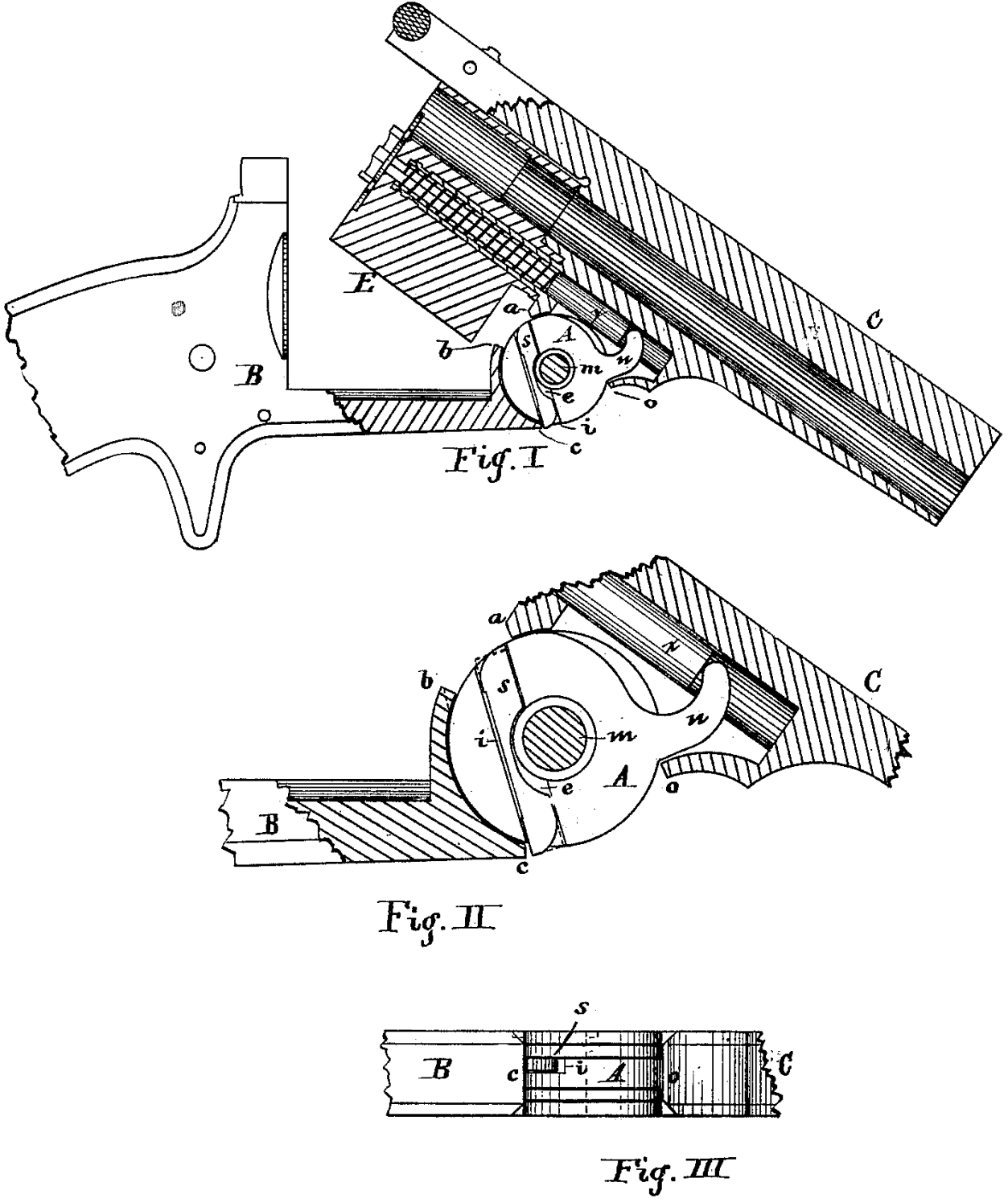US 227481
UNITED STATES PATENT OFFICE
JAMES H. BULLARD, OF SPRINGFIELD, MASSACHUSETTS, ASSIGNOR TO DANIEL B. WESSON.
REVOLVING FIRE-ARM.
SPECIFICATION forming part of Letters Patent No. 227,481, date May 11, 1880.
Application filed December 29, 1879
To all whom it may concern:
Be it known that I, JAMES H. BULLARD, of Springfield, in the county of Hampden and State of Massachusetts, have invented a new and useful Improvement in Revolving Fire-Arms; and I do hereby declare that the following is a full, clear, and exact description thereof, reference being had to the accompanying drawings, and to the letters of reference marked thereon.
The object of my invention is to provide an economical and effective means of operating the extractor-lifter which operates the extractor of a revolving firearm; and to this end my invention consists of a slide arranged to move to and fro in the lifter and operated by shoulders made upon the arm in the ordinary movements of tilting the barrel upon the frame in extracting the shells from the cylinder, as will be more fully hereinafter set forth.
Figure I is a vertical longitudinal section of a revolving fire-arm through the barrel and that portion of the frame in which the lifter is secured, showing my invention applied thereto. Fig. II is an enlarged longitudinal sectional view of the arm at the joint, showing the lifter, its slide, and that portion of the arm immediately adjacent thereto. Fig. III is a bottom view of the joint, showing the lifter, and the end view of the slide operating therein.
In the drawings, C represents the barrel of a revolving fire-arm; E, the cylinder secured thereto, and B the frame, in the forward part of which, in the barrel-hinge, is placed the lifter A, secured in place by the hinge-pivot m, upon which it turns and operates the extractor by its finger n.
A recess, i, is made in the side of the lifter, in which is fitted, to move to and fro, a slide, s, having a portion of its edge at e cut away, so that the hinge-pivot m, which partially fills the cavity e, may limit the movement of the slide.
The upper end of the slide may be rounded or beveled, so that as the rear end of the barrel is tilted down to close the breech the upper end of the slide, as it is moved down by contact with the shoulder a of the barrel, may readily pass under and the slide be easily forced in by the shoulder b on the frame, and the lower end of the slide may be beveled or rounded for the same purpose of easy movement by contact with the shoulder o on the barrel.
The lifter, otherwise than being arranged to contain the slide s, is made in the ordinary manner, being arranged to turn on the pivot m, and provided with a finger, n, to bear against the end of the extractor.
The operation of my invention is as follows: When the barrel is in a position with its rear part secured or latched to the upper part of the frame, and it is desired to extract the empty shells from the chambers of the cylinder, the barrel is unlatched from the frame and its forward end tilted down, which causes the forward end of the extractor-stem to bear against the finger n of the lifter and turn the latter on the pivot m. This causes the lower side of the slide, at its forward end, to strike against the shoulder c on the frame, which prevents the lifter from turning farther until the extractor has been forced rearward by the finger n sufficiently to extract the shells from the cylinder, and when the shoulder o on the barrel passes down it strikes the beveled forward end of the slide and forces it upward sufficiently to pass inside the shoulder c, when the lifter is then released, and the extractor-spring forces the extractor quickly forward, and the lifter flies around on the pivot m, until the upper part of the rear end of the slide strikes against the shoulder a on the barrel, where it is stopped. The rear end of the barrel being then tilted down, the shoulder a carries down the rear end of the slide and turns the lifter back to its first position again, ready to extract the shells when the forward end of the barrel is again tilted down.
In order that the slide may remain in any position into which it may be moved, a small portion of its side may be cut away and a friction-spring be inserted; or the slide itself may be slightly curved and made elastic, and then be forced into its straight recess in the lifter; or the slide may be straight and fit its recess in the lifter sufficiently close for that purpose.
Having thus described my invention, what I claim as new is–
The combination, with the extractor of a fire-arm and its actuating-spring, of the lifter A, located at the hinge which secures the barrel to the frame, and a slide, s, arranged to be moved longitudinally therein by contact of the shoulders of the frame and barrel with the ends of the slide when the barrel is tilted upon its hinge, substatially as described.
JAMES H. BULLARD.
Witnesses:
T. A. CURTIS,
E. E. CURTIS.

